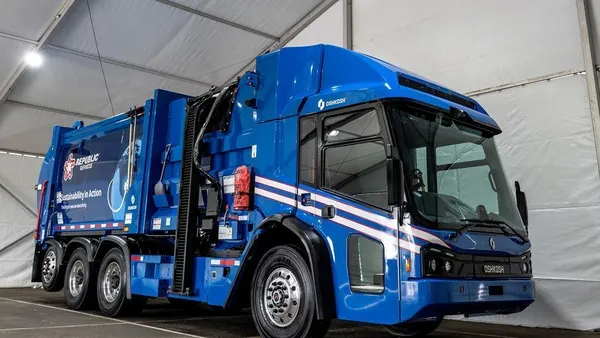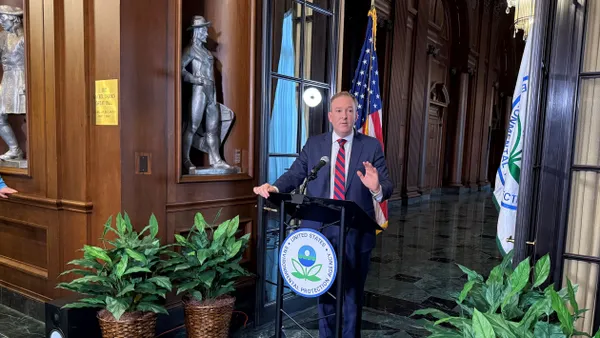Dive Brief:
- A coalition of nine states and the Environmental Defense Fund (EDF) filed a brief earlier this month over the U.S. EPA's "delay rule," which has stalled landfill methane regulations. The Aug. 12 brief was filed with the U.S. Court of Appeals for the District of Columbia Circuit, with attorneys general from California, Illinois, Maryland, New Jersey, New Mexico, Oregon, Rhode Island, Vermont, and Pennsylvania among the petitioners.
- EDF confirmed the brief is separate from litigation started in May 2018 over delaying federal implementation of the 2016 Emissions Guidelines (EG) rule, also involving the environmental group and all of the same states apart from New Jersey. The target of the new action is more concerned with shifting deadlines — EPA published its final EG rule in August 2019, giving itself two years to promulgate a federal plan for states that do not submit their own plans under the EG requirements.
- The new brief targets the agency's timing and states "EPA has deployed a series of tactics to delay implementing the standards, without ever providing a valid reason for doing so." The petitioners are asking the court to vacate the delay and require the agency to immediately implement the rule, saying any further stalling will have adverse environmental and public health effects.
Dive Insight:
Sources familiar with the two cases over the EG rule said both challenge the ways in which EPA has not implemented regulatory protections immediately, albeit in different ways. The first case targeted the agency's initial lack of activity on the EG rule, while the second concerns the affirmative changing of its deadline.
The EG rule applies to any MSW landfills accepting waste since Nov. 8, 1987. The EPA issued those guidelines when it finalized its New Source Performance Standards (NSPS) rule aiming to reduce methane emissions from newer landfills, a significant contributor to climate change per the agency's own findings.
The actions require landfills to install and operate a gas collection control system in the 30-month period after their emissions reach 34 metric tons of nonmethane organic compounds, lower than the previous threshold of 50 metric tons. According to EPA's assessment of NSPS and the EG rule, more than 1,900 sites could be impacted across the country.
Groups including the National Waste and Recycling Association and Solid Waste Association of North America pushed back on the EG rule, as did companies like Waste Management and Republic Services. Under former EPA Administrator Scott Pruitt, the agency stayed the rule and did not take action once that stay expired, resulting in the initial 2018 lawsuit.
That separate litigation is currently on appeal to the U.S. Court of Appeals for the Ninth Circuit. Last year, EPA appealed after Judge Haywood Gilliam of the U.S. District Court for the Northern District of California first ordered the agency to meet its "nondiscretionary duties" under the Clean Air Act and later denied a request from the agency to shift its implementation timeline.
EPA published a federal rule last year, giving states until Aug. 29, 2019 to submit their plans — an extension from the original May 30, 2017 deadline. The agency also gave itself six months to review if state plans are complete and an additional year to review those plans, along with giving itself until August 2021 to promulgate the federal rule. The new Aug. 12 legal action takes aim at that delay, stating it "exemplifies arbitrary and capricious agency action" and departs from the spirit of the Clean Air Act.
"EPA tried to change those deadlines after it lost in the California court, and our D.C. Circuit case challenges the new, delayed deadlines as unlawful," said EDF Media Director Sharyn Stein.
A spokesperson for EPA said the agency does not comment on pending litigation and did not clarify the agency's timeline for implementation of the EG rule.
EPA published a notice in the Federal Register on March 12 saying 42 states and territories had not submitted plans for the agency's review, meaning all would be subject to the federal plan. EPA has approved or partially approved state and county plans for California, Arizona, New Mexico, Delaware, West Virginia, and Virginia. Final state plans or negative declarations from New York, Oregon, Vermont, Philadelphia, South Dakota, and Washington, D.C. are under review, and other areas have indicated they intend to submit as well.













